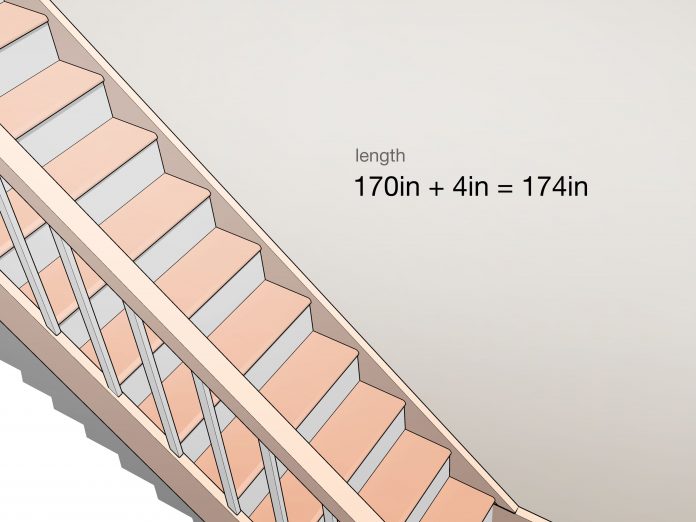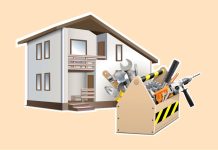Determining how much floor covering must be covered is one of the most troublesome parts of laying out a carpet installation. The floor covering on the steps is occasionally introduced as a single piece. And the statue requires incredible tender care. Unless your house is specially manufactured. The steps should meet the more extensive size standards. Keep in mind that building codes will vary from region to region, so you may be slightly different. Make sure to measure carefully! Steps how to measure stairs for carpet various shapes, sizes, and designs.
Here are the various steps you can usually find at home:
Table of Contents
How to measure stairs Step by Step
After reading this full step about How to measure stairs
Box stairs
The container steps are straight. Without railings, and are surrounded by all sides.
Usually about 3’wide.
The usual allowance for the track (the horizontal part you step on) is 10″, and the riser (the back of the steps) is 8″. Therefore, for each container step, you need 3′(or the width of the level) x 18″ floor covering.
Top stairs
Compared with the case step (consolidated 18 inches), there is no difference in the track and riser estimation.
You will need approximately 4’of carpet to cover the width so that the carpet passes through the columns and folds outside the steps.
If you have no guardrails on either side of your footrest (the top is double), you will need a carpet of about 5 feet thick to cover the width.
Pie Stairs/Wring of how to measure stairs
This is the most essential part of know the “How to measure stairs.”
The curved steps are called pie steps or winding machines.
The general rule is that for each pie step, you need a 4′(or the width of the level) x 30″ floor covering-this This takes into account that the installer needs to move the carpet to find the most suitable location.
Open the stairs
- The open step (called the Hollywood step in some cases) is unsupported.
- Measure your stride length to determine the width.
- You will need about 20 inches of floor covering to completely wrap the entire step.
Cown
- A bull-nose step is usually found at the bottom of a stepped staircase.
- It is more extensive than the remaining steps and can be adjusted on one or both sides.
- There is no difference between the estimated value of the connected track and riser and the container step (18″).
- Measure the levels to determine the width-in more massive stairs; the width can be extensive.
- You need a bit of floor covering, which is the width of the steps, plus some extra creep to fold 18 inches on the track’s outer edge.
Pile process
The floor covering on the steps must be inconsistent on each level, and the header of the stack must float with traffic-through, not from side to side. This means that to adapt to the movement of the floor covering. Not all steps are incorporated into a whole.
Determine your requirements
To determine how much floor covering is needed for a complete set of equipment. You should know the full loom (usually 12′, but sometimes 15′). And then, you can calculate the number of steps based on the above measurements.
Usually, there are 13 steps for the flight from the main floor of the house to the second floor, and 12 levels for the flight from the base floor to the wine cellar. However, do not merely accept this because a higher roof height may mean more steps.
model of how to measure stairs
For the usual arrangement of 12 steps estimated to be 3’wide. Using a 12′ full floor, you will need 12’x 4’6″ (in a 12′ full carpet. You need 4 steps-12′ divided into 3′-So every 12’x 18″ gives you 4 steps).
For a curved staircase that is open on one side and contains 12 top pie-shaped steps (no bull-nosed steps), you need a 12′ x 10′ floor covering.
additional
No matter how many floors covering you need. You should always buy something extra when introducing it. To account for any peculiarities or slippage.
Steps to estimate cover steps
Measuring step
The step tracking is the level or even part of the level you step on. Using a tape measure, measure the width and depth of the track, and record each estimate.
If you plan to use a floor-covered sprinter on the steps that do not cover the entire width of the steps, just measure its diameter.
If your pedal string is hanging on the riser (the vertical part of the pedal) at this time, you must quantify the protruding edge of the series to the position where it contacts the riser.
Measurement ladder
The step is the vertical part of the level on which the track is located. Measure the height of the riser. If your actions are measured straight and evenly, then the width should be equal to the tread width.
Include your estimate
When you have the depth of the track and the figure of the ascender at the same time, you should combine these two results. In this way, you can copy this number according to the width of the steps (or the area to be covered) to obtain. The total field of the carpet is required to advance alone.
Increase the complete area of a stage by the number of steps that need to be covered. In each case, it is best to have a little excess floor covering and then insufficient. Therefore, if you need padding for each step, you need to leave an extra 2.5 cm each time you proceed, generally 50 cm more.
Measure the floor of the stairs
How can I measure the coverage of corner steps?
If you have a stepped winding machine, you can still calculate straight strides despite using the above techniques, and corner strides require unique strategies.
You need to measure all curved steps independently to get accurate results. First, measure the width of the corner step at the most significant point. At that point, measure the absolute length of the progress from the deepest point of the growth. This means to estimate downward from the corner of the intersection of the track and the dividing line until you reach the lowest section of the step.
It is safe to say that you are looking for quality carpets at an incredible value? Take a look at the operation of our carpets, or contact a colleague; they will be happy to handle the inquiry.
Know your stairs of how to measure stairs
First, we should discuss some wording. The track is the part you keep. In many houses, its standard height is 10 inches, but the ideal situation is to just measure your footsteps is not a big chance. The riser is the horizontal part of the back of the step, which faces the trip when your foot jumps. That is usually 8 inches high.
The container of how to measure stairs is the most challenging form.
It mostly has a track, and a riser for the combined 18 surface crawls for each step. Increase it by the step size (usually the standard 36 inches), increase the number of steps that must be covered, and then get the last number. Recall that there are many more risers than rails-the the end of the steps is just the floor of the upstairs hall, so you don’t have to express it independently.
The top floor has an open side with railings above it. There is probably no difference between its connection length and the container steps at 18 creeps, but you need to add an extra foot of width to the floor covering to fold it onto the edge of the pillars and steps. You can also choose to stop the floor covering in front of the uprights; in this case, you don’t need extra width. The equivalent steps are twofold-put a foot on each side.
Also called a winder. You need the texture of the floor covering to match the carpet in the remaining steps. So the shape of these devices is usually not estimated. Instead, plan a 48″ x 30″ piece for each winding machine so that the installer can move the floor to achieve the best fit.
The open step or the Hollywood step are steps that are not supported.
But if you don’t want to include these steps, in addition to multiple times of progress. You need at least 20 creeping ground covers to fold them up.
The dimensions of the rails and risers should be similar to the crate’s levels, but the width may be more extensive. In addition to a few other crawls to fold on the outer edges, you will also need some floor to cover the width of the most stretched step.
Finally, if your steps protrude on the track elevation of the suspension, in addition to the erector, you must add three more creeps to the 18″ track.
A few examples of how to measure stairs-
We should start with simple box-like steps. If you want to run a 12-step rolling mill, you will replicate the 36-inch width with 18-inch rails and risers, and then add 12 steps. Very simple, isn’t it?
Currently, how do we deal with an increasingly complex case? Nose walk 15 steps, there is a railing on one side. So, three of them are pie steps.
This is the way of mathematical calculation.
Pie steps: three pieces, each 48″ x 30″, with a total area of 4320 square inches.
Top steps of how to measure stairs:
- 12 steps, each step is 48 inches wide and rises 3 inches.
- The track rises 10 inches.
- The height of the nose is 3 inches.
- The absolute value is 12,096 square inches.
- Absolute square inches: 16,416
- Complete square feet: 114
Although it is only a foot wide and a few steps higher, you can feel that this stepped staircase requires twice as much carpet to cover! You don’t want to miss the mark. And you don’t want to be shocked by the amount of money it spends.
Now that you have your estimate, please use 10% for health.
Without cutting and modifying to a large extent, it is challenging to introduce cover plates, especially on steps, so you can accept parts beyond your needs.
Through these strategies. You can determine exactly how much floor you need to cover so that you can enter our distribution center and provide specific numbers. That needs to be purchased and considered. With our professional installer system, we will cover all the steps and provide you with new knowledge in a short time!
After reading this full article (How to measure stairs), what are you think? If you have any queries about How to measure stairs, please write your question on below comment section. So, we will try to share information.








